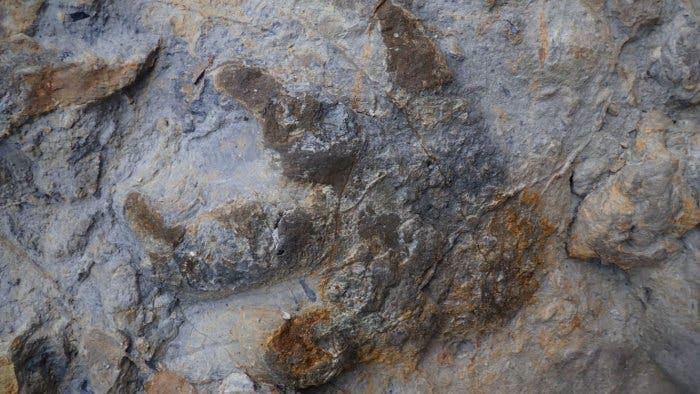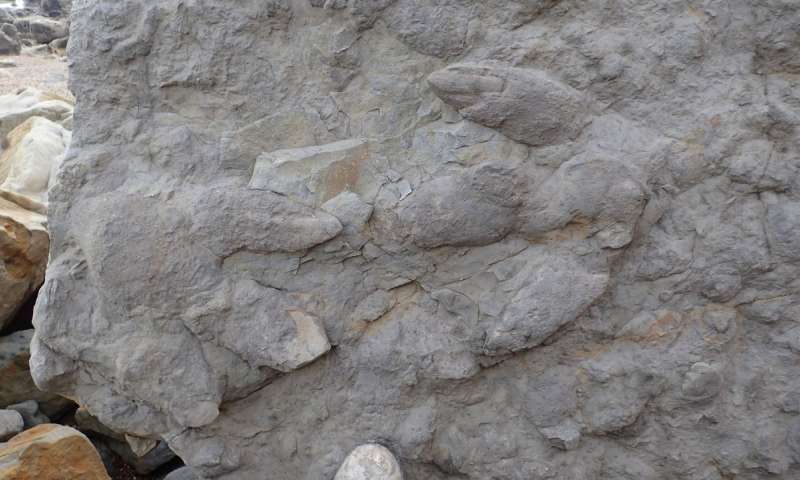They’re the most detailed and well-preserved dinosaur tracks ever found in England.
At least 85 dinosaur footprints have been discovered in East Sussex, southern England — relatively close to the town of Hastings, where William the Conqueror won one of the most famous battles in history in 1066, essentially starting his conquering of England. But way before William was making his way across the English Channel, England had a completely different set of occupants: dinosaurs.
The footprints date from the Lower Cretaceous epoch, between 145 and 100 million years ago, and are a very varied bunch, belonging to herbivores including Iguanodon, Ankylosaurus (a species of stegosaur), as well as species from the sauropod group (which included Diplodocus and Brontosaurus) and meat-eating theropods (the group to which T-Rex also belonged).
The discovery is extremely fortuitous. Not only would there need to be a very particular environment to draw all these dinosaurs together (like a water source) but the conditions need to be exactly right to ensure that the tracks are fossilized and not destroyed over the course of more than 100 million years. It’s like finding a needle in a geological haystack.
“Usually you only get small pieces, which don’t tell you a lot about how that dinosaur may have lived. A collection of footprints like this helps you fill in some of the gaps and infer things about which dinosaurs were living in the same place at the same time,” said Anthony Shillito, a Ph.D. student in Cambridge’s Department of Earth Sciences and the paper’s first author.
Shillito co-authored the study with Dr. Neil Davies. Together, the two spent the past four winters looking for fossils. Over the past two centuries, there have been sporadic mentions of fossil tracks in the area, but nothing of this caliber. However, the two got lucky as strong storms and surges collapsed chunks of the sandstone and mudstone cliffs, revealing the perfectly preserved tracks
“To preserve footprints, you need the right type of environment,” said Davies. “The ground needs to be ‘sticky’ enough so that the footprint leaves a mark, but not so wet that it gets washed away. You need that balance in order to capture and preserve them.”
“As well as the large abundance and diversity of these prints, we also see absolutely incredible detail,” said Shillito. “You can clearly see the texture of the skin and scales, as well as four-toed claw marks, which are extremely rare.
The quality of the footprints allows paleontologists to understand some finesse elements about the dinosaurs’ impact on their ecosystems. For instance, Shillito is studying how dinosaurs may have affected the flows of rivers. In modern times, biologists have observed how large animals such as hippos or even cows can create tiny channels that affect the flow of rivers — it’s quite likely that big dinosaurs would have done the same thing.
“Given the sheer size of many dinosaurs, it’s highly likely that they affected rivers in a similar way, but it’s difficult to find a ‘smoking gun’, since most footprints would have just washed away,” said Shillito. “However, we do see some smaller-scale evidence of their impact; in some of the deeper footprints you can see thickets of plants that were growing. We also found evidence of footprints along the banks of river channels, so it’s possible that dinosaurs played a role in creating those channels.”
If the storms and surges will continue, we may witness more and more dinosaur tracks being exposed. However, this erosion can also be dangerous, so authorities have constructed sea defenses in the area to prevent this from happening.
Journal Reference: Anthony P. Shillito et al, Dinosaur-landscape interactions at a diverse Early Cretaceous tracksite (Lee Ness Sandstone, Ashdown Formation, southern England), Palaeogeography, Palaeoclimatology, Palaeoecology (2018). DOI: 10.1016/j.palaeo.2018.11.018
.











